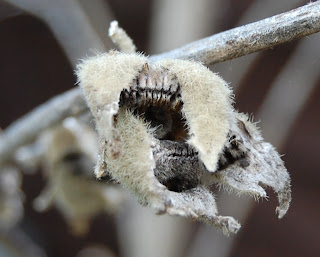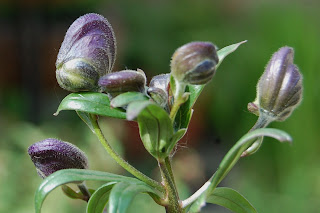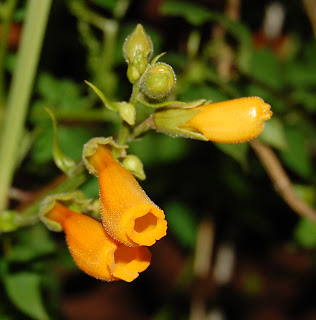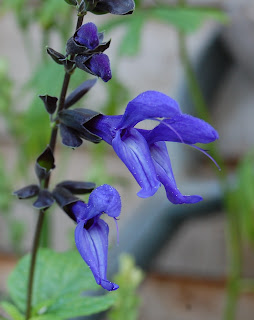I find Paphiopedilums fascinating!
It may be that my fascination comes from the fact that I killed a couple - full of good intention, I religiously misted them twice daily. Then someone far wiser than me suggested that this was the very thing that was killing them. Apparently, they do not like water collecting in the crowns (although how they deal with rainwater in the wild remains a mystery to me).
So now I have three. A Paph. pinnocchio, and two noid Paphs. One of the noids is a rescue plant, saved from someone who kept it stood in a bowl of water. One year on, it now has five healthy leaves! No great shakes you may think, but all that I had to work with was the smallest of new crowns on an otherwise dead plant. The other noid is the subject of the following series of photographs.
As the flower buds of a Paphiopedilum open, they seem to take on a variety of "faces", from slightly sinister (almost predatory) to what seems downright comical (to me anyway)!
This particular noid looks to be a hybrid of P.glaucophyllum and an unknown parent. It's a strong sequential bloomer which appeared to enjoy it's time outdoors this summer and continues to bloom having been bought back indoors. It has now been in bloom for ten months with no end in sight. Paph. glaucophyllum can start a new flower spike from another part of the plant before the old spike has finished, effectively becoming ever flowering. How nice would it be if I'm correct about the parentage of this noid and it were to inherit this characteristic!
Friday, 10 December 2010
Monday, 6 December 2010
Guess what this is......
I found this photograph whilst I was cleaning out the files on my computer earlier.....
Just for fun, anyone want to join the fun and take a punt at what it is?
Just for fun, anyone want to join the fun and take a punt at what it is?
Tuesday, 30 November 2010
Flower buds.....
Sometimes we look forward to our plants blooming so much that we don't notice how attractive the buds, or the blooms as they open, are.
So what follows is nothing more than a collection of buds and blooms as they open.....
So what follows is nothing more than a collection of buds and blooms as they open.....
Gloriosa Superba
Aconitum "Sparks Variety"
Datura Meteloids
Centaurea montana
Abutilon
Fuchsia magellanica
Clerodendrum ugandense
Cleome spinosa
Tibouchina urvilliana
Salvia patens
Polygala myrtifolia
Monday, 22 November 2010
Climbers (part two)
This second (part one is here) and final part about our climbers kicks off with a very hardy Clematis....
Personally, I'm not a great lover of Clematis, but this one has always been there (hence, I don't know it's name), but it blooms prolifically in the early summer. The flowers are about 60/70mm in size.
Rhodochiton atrosanguineum (Purple Bell vine) is far too tender to survive outside in the UK winter. The good news is that it usually makes it through if placed in an unheated garage, shed or greenhouse and kept dry. It's also very easily grown from the seeds that it produces plenty of.....
I'm lucky enough to have three Sollya heterophylla, two in blue and one of the white form. Sollya is the old name, the "new" one being Billardiera heterophylla (why do they have to keep doing this). The common name is Bluebell Creeper.....
This has a vigorous growth habit, but once again is too tender for our winters. Mine come into the conservatory for the winter where they continue to grow well. But, and it's a big but, they're very susceptible to the dreaded red spider mite.
Eccremocarpus scaber (Chilean Glory flower) is thought of as tender over here, but I've always found it to be anything but! Another plant which is very easily grown from the masses of seeds that it produces.
If it has one drawback, it is that it grows very quickly indeed and will need to be trimmed or tied up as you require on a regular basis.
Here in the UK, Gloriosa superba is thought of as an exotic, which seems odd to me as it's so easy!
Chuck the tubers into fresh soil (in a pot) March time, water in and place in the conservatory or greenhouse. Give it something to climb up, water only as it gets to the point of starting to wilt and that is it. I withdraw water in September and allow it to dry out fully, before putting it in a cupboard for the winter and repeating the whole process again the following spring.
Hopefully, this time next year I should have a few more to show off. I have some Allamanda seeds on the way, hopefully Plumbago too. And in January, a friend is off to India and has promised to return with some Thungergia grandiflora seeds. I can't wait!
Personally, I'm not a great lover of Clematis, but this one has always been there (hence, I don't know it's name), but it blooms prolifically in the early summer. The flowers are about 60/70mm in size.
Rhodochiton atrosanguineum (Purple Bell vine) is far too tender to survive outside in the UK winter. The good news is that it usually makes it through if placed in an unheated garage, shed or greenhouse and kept dry. It's also very easily grown from the seeds that it produces plenty of.....
I'm lucky enough to have three Sollya heterophylla, two in blue and one of the white form. Sollya is the old name, the "new" one being Billardiera heterophylla (why do they have to keep doing this). The common name is Bluebell Creeper.....
This has a vigorous growth habit, but once again is too tender for our winters. Mine come into the conservatory for the winter where they continue to grow well. But, and it's a big but, they're very susceptible to the dreaded red spider mite.
Eccremocarpus scaber (Chilean Glory flower) is thought of as tender over here, but I've always found it to be anything but! Another plant which is very easily grown from the masses of seeds that it produces.
If it has one drawback, it is that it grows very quickly indeed and will need to be trimmed or tied up as you require on a regular basis.
Here in the UK, Gloriosa superba is thought of as an exotic, which seems odd to me as it's so easy!
Chuck the tubers into fresh soil (in a pot) March time, water in and place in the conservatory or greenhouse. Give it something to climb up, water only as it gets to the point of starting to wilt and that is it. I withdraw water in September and allow it to dry out fully, before putting it in a cupboard for the winter and repeating the whole process again the following spring.
Hopefully, this time next year I should have a few more to show off. I have some Allamanda seeds on the way, hopefully Plumbago too. And in January, a friend is off to India and has promised to return with some Thungergia grandiflora seeds. I can't wait!
Friday, 19 November 2010
Climbers (part one)
The great thing about climbing plants is that by their very nature, they always (well nearly always) give outstanding results for relatively little effort.
I've had a couple of failure this year! And in both cases for the same reason! I planted Ipomea "Heavenly Blue" and Cobea scandens alongside one of the most prolific climbers that I've ever grown - Aserina scandens.........
We've also trained a Jasmine over steel tubing, which over the course of ten years or so has created a natural archway........
A classic traditional summer climber here in the UK is the good old Sweet Pea; this is the perennial form (Lathyrus latifolius).........
On the back wall we have a Hydranga (which I have to admit, I know nothing about as it's always been there)
As this is getting a bit longer than I'd anticipated, I'll close it for now with a beauty that had mixed fortunes. Tropaeolum perigrinum.....
Part two can be found here
I've had a couple of failure this year! And in both cases for the same reason! I planted Ipomea "Heavenly Blue" and Cobea scandens alongside one of the most prolific climbers that I've ever grown - Aserina scandens.........
......a delicate little flower, but if you're not careful you end up with this.........
That is about half of five plants in that photo! It has it's uses though, one of which is covering nasty wooden fences! Just don't try to plant anything with it!We've also trained a Jasmine over steel tubing, which over the course of ten years or so has created a natural archway........
The small flowers are incredibly fragrant!
A classic traditional summer climber here in the UK is the good old Sweet Pea; this is the perennial form (Lathyrus latifolius).........
On the back wall we have a Hydranga (which I have to admit, I know nothing about as it's always been there)
As this is getting a bit longer than I'd anticipated, I'll close it for now with a beauty that had mixed fortunes. Tropaeolum perigrinum.....
AKA The Canary Creeper
It's a delightful climber, with small flowers of 20mm, but something of a pest magnet! First it was blackfly (water and washing up liquid took care of them, followed my the cabbage white caterpillar which are easily picked off. But then it got attacked by flea beetles which killed it in two days flat! Despite all that, it has it's uses - nothing else in the garden (apart from my Cleomes, which are an annual feast for the cabbage white caterpillars) was bothered by pests. I remember my Grampy growing Nasturtiums strategically around his veg patch for the same reason. So it will be back next year, because whilst it lasts it is rather lovely!Part two can be found here
Wednesday, 17 November 2010
Oxford botanic gardens (part two)
Following on from my first post (part one is here) I'd like to share a few more of the more tropical gems that have been on display during 2010.
My first picture is of Ruizia Cordata, which is a small tree growing in the walkway connecting the various glass-houses. It's flower buds are far more attractive than the flowers themselves......
Ruizia Cordata is a member of the Malvaceae family and is only found growing in the wild on Reunion Island.
My next two photos are both climbing plants.
Clytostoma Callistegioides (Violet Trumpet Vine?) is a South American native.....
.......and Allamanda Cathartica
........which is also native to South America (Brazil). I have heard that gardeners in places such as California regard this as overly invasive - if that's true, try gardening in the UK! I'd love this outdoors!
Finally, before you wander off, one from the cactus house; Dasylirion Wheeleri........
.........which has such a perfect shape to it! Another South American plant, this time native to areas of northern Mexico.
Hope you enjoyed this brief look at our botanic garden!
My first picture is of Ruizia Cordata, which is a small tree growing in the walkway connecting the various glass-houses. It's flower buds are far more attractive than the flowers themselves......
Ruizia Cordata is a member of the Malvaceae family and is only found growing in the wild on Reunion Island.
My next two photos are both climbing plants.
Clytostoma Callistegioides (Violet Trumpet Vine?) is a South American native.....
.......and Allamanda Cathartica
........which is also native to South America (Brazil). I have heard that gardeners in places such as California regard this as overly invasive - if that's true, try gardening in the UK! I'd love this outdoors!
Finally, before you wander off, one from the cactus house; Dasylirion Wheeleri........
.........which has such a perfect shape to it! Another South American plant, this time native to areas of northern Mexico.
Hope you enjoyed this brief look at our botanic garden!
Tuesday, 9 November 2010
My orchids
I'm no orchid expert, but I do like to have a few about. I haven't killed any yet, and can now get reblooms. I do however seem to be really good at getting plenty of new growth! But as I now move them around the house in order to offer them different levels of light and heat, more and more are producing flower spikes.
Most of my orchids are just Phalaenopsis noids, but I have a couple of Paphiopedilums and this year successfully grew and bloomed Habenaria Radiatta.
Most of my orchids are just Phalaenopsis noids, but I have a couple of Paphiopedilums and this year successfully grew and bloomed Habenaria Radiatta.
Bit of a love it or hate one!
Bought in bloom like this, but as soon as this spike finished it started producing another, and should be back in bloom in the next few weeks!
Lovely little dwarf gift that bloomed all summer outdoors!
A gem of a bloomer, that has been in flower since April. Now has six flowering spikes!
This rebloom was also put outdoors for the summer. Bought it indoors a few weeks ago, it has responded by throwing out a new flower spike.
A Paphiopedilum noid with a sequential flowering habit. Happily flowered all summer outdoors, but suffered bud blast when bought back indoors. Now that it's adjusted it's forming new buds again. Another that started flowering way back in April!
My pride and joy this year! Habenaria radiatta (White Egret orchid).
Read a few stories of this terrestrial orchid being a little tricky, so I went instead for the option of growing it in a pot. Made up a medium consisting of sphag moss, bark chips which I beat up a bit in a pestle and mortar, perlite and vermiculite. It's eventual site got early morning and late evening sun. The only other point to observe it to keep it constantly moist, which is why my medium was a bit of a mix - the last thing that I wanted was to risk the small tubers rotting!
Bye for now....
Thursday, 4 November 2010
Garden Blues (part two)
Following on from yesterday, yet more of the blue flowers in my garden this year.
I'll start off with a trio of Campanula - the first one was a small plant that I bought last year which has done a pretty good job of taking over this summer. The early blooming C.glomerata........
.......followed by C.persicifolia, which I started off from seed last spring
My third Campanula is C.punctata.......
Perennial Lobelias are my favourite garden plant and this is L.siphilitica..........
It performs best in the shade and likes to be kept moist. As with all my Lobelias, in September I gently tug out and pot up new shoots to be kept under cover over the winter in order to replace any losses.
The next photo was a present of bird poo I think, as it sprang up between the paving slabs! I think (and I may be wrong) that this low grower is called Isotoma. Either way, a nice surprise!
The final two are both Salvias - firstly Salvia "Black and Blue"..........
......... which is rumoured to be a little tender so I have a cutting under cover just in case.
The Salvia patens above was only started from seed in July in preparation for next year. One of them has decided to flower though so, as I have more than enough for my needs, I've bought it into the conservatory.
Next time, I'll concentrate on the tender blues that have thrived outside this summer.
I'll start off with a trio of Campanula - the first one was a small plant that I bought last year which has done a pretty good job of taking over this summer. The early blooming C.glomerata........
.......followed by C.persicifolia, which I started off from seed last spring
My third Campanula is C.punctata.......
Perennial Lobelias are my favourite garden plant and this is L.siphilitica..........
It performs best in the shade and likes to be kept moist. As with all my Lobelias, in September I gently tug out and pot up new shoots to be kept under cover over the winter in order to replace any losses.
The next photo was a present of bird poo I think, as it sprang up between the paving slabs! I think (and I may be wrong) that this low grower is called Isotoma. Either way, a nice surprise!
The final two are both Salvias - firstly Salvia "Black and Blue"..........
......... which is rumoured to be a little tender so I have a cutting under cover just in case.
The Salvia patens above was only started from seed in July in preparation for next year. One of them has decided to flower though so, as I have more than enough for my needs, I've bought it into the conservatory.
Next time, I'll concentrate on the tender blues that have thrived outside this summer.
Subscribe to:
Comments (Atom)
























































